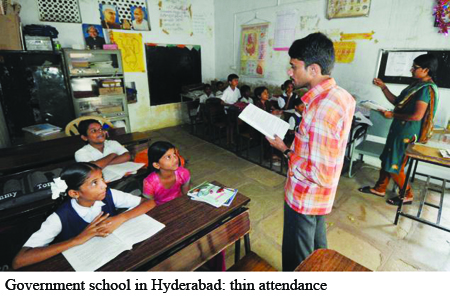The Andhra Pradesh government is all set to shut down 880 government primary schools in the state before the next academic year beginning July. Primary education minister S. Shailajanath of the Congress party government held a meeting with officials, educationists and voluntary organisations in early April to explain that the 880 primary schools spread across several districts of the state, have proved to be unviable, with some of them having no students at all.
Educationists in Andhra Pradesh (pop. 84 million) attribute thin attendance in government schools to pathetic infrastructure and indifferent teachers, for remedying which the beleaguered Congress government in the state — confronted with a split in the party and the unending Telangana agitation — has had little time or inclination. According to NGO estimates 47,000 of the 76,000 government primaries in the state don’t have toilets or drinking water facilities. The website of the Sarva Shiksha Abhiyan (SSA) programme indicates that 53,801 primary, upper primary and higher secondary government schools in the state haven’t installed separate toilets for girl children. Such apathy despite the Supreme Court on three occasions directing all state governments to provide these basic facilities in all schools.

Responding to a petition filed by the Delhi-based Environmental and Consumer Protection Foundation which had sought a directive to state governments to implement the Right to Free & Compulsory Education (aka RTE) Act, 2009, a two-judge bench of the court observed: “Right to free and compulsory education of children in the age group 6-14 is part of the fundamental rights guaranteed under Article 21-A. This right cannot be enjoyed unless infrastructure is provided by the state.’’
Against this backdrop, education NGOs are highly critical of the state government for not utilising funds granted by the Centre for infrastructure development. “Viability is an inappropriate word to use for the education and health sectors. The state government has returned Rs.300 crore allocated for infrastructure back to the Centre. It then blames poor infrastructure for student flight and closes down schools. This is a ridiculous argument,’’ says M.S. Chandra, director, CARPED (Centre for Action, Research and People’s Development).
R. Srinivas Reddy, the general secretary of the Hyderabad chapter of the State Teachers’ Union of Andhra Pradesh, believes the state government’s “cavalier attitude’’ towards shutting down government schools signals a move towards encouraging private schools. “Many of our lady teachers are facing great difficulties in attending to their duties given the poor infrastructure of government schools. Closing down schools and trying to save money on grants and rents is not the solution. The state government should upgrade infrastructure and hire more teachers to make government schools attractive,’’ he says.
Yet perhaps the major causes of the flight of children from free-of-charge government primary-secondaries are teacher absenteeism, multigrade teaching, poor learning outcomes and reluctance to seriously teach English — the language of upward social mobility. On the other hand, Andhra Pradesh hosts 26,216 recognised private schools, and also the largest number (in proportion to population) of private ‘budget’ schools — essentially slum schools promoted by committed for-profit education entrepreneurs charging modest tuition fees of Rs.100-500 per month.
The mushroom growth of private budget schools for which low-income households vote with their wallets is described by Dr. James Tooley in his highly influential book The Beautiful Tree: A Personal Journey into how the World’s Poorest People are Educating Themselves (2009). According to the National University of Educational Planning and Administration, Delhi, 41.17 percent of in-school children in Andhra Pradesh are enrolled in recognised private schools. It’s a fair bet that another 30 percent-plus are learning in private budget schools in the state.
With an estimated 70 percent children having fled reform-proof government schools in the state, it’s more than likely that the number of student-less govern-ment schools required to shut down will balloon.
Aruna Ravikumar (Hyderabad)